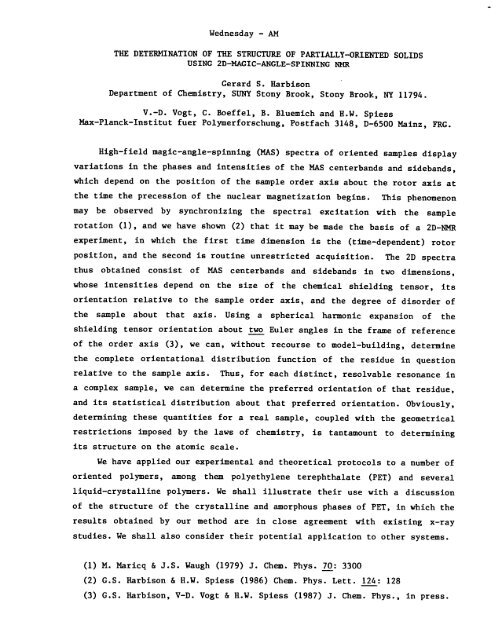th - 1987 - 51st ENC Conference
th - 1987 - 51st ENC Conference
th - 1987 - 51st ENC Conference
You also want an ePaper? Increase the reach of your titles
YUMPU automatically turns print PDFs into web optimized ePapers that Google loves.
Wednesday - AM<br />
THE DETERmiNATION OF THE STRUCTURE OF PARTIALLY-ORIENTED SOLIDS<br />
USING 2D-MAGIC-ANGLE-SPINNING N}~<br />
Gerard S. Harbison<br />
Department of Chemistry, SUNY Stony Brook, Stony Brook, NY 11794.<br />
V.-D. Vogt, C. Boeffel, B. Bluemich and H.W. Spiess<br />
Max-Planck-Institut fuer Polymerforschung, Postfach 3148, D-6500 Mainz, FRG.<br />
High-field magic-angle-spinning (MAS) spectra of oriented samples display<br />
variations in <strong>th</strong>e phases and intensities of <strong>th</strong>e MAS centerbands and sidebands,<br />
which depend on <strong>th</strong>e position of <strong>th</strong>e sample order axis about <strong>th</strong>e rotor axis at<br />
<strong>th</strong>e time <strong>th</strong>e precession of <strong>th</strong>e nuclear magnetization begins. This phenomenon<br />
may be observed by synchronizing <strong>th</strong>e spectral excitation wi<strong>th</strong> <strong>th</strong>e sample<br />
rotation (I), and we have shown (2) <strong>th</strong>at it may be made <strong>th</strong>e basis of a 2D-NMR<br />
experiment, in which <strong>th</strong>e first time dimension is <strong>th</strong>e (time-dependent) rotor<br />
position, and <strong>th</strong>e second is routine unrestricted acquisition. The 2D spectra<br />
<strong>th</strong>us obtained consist of MAS centerbands and sidebands in two dimensions,<br />
whose intensities depend on <strong>th</strong>e size of <strong>th</strong>e chemical shielding tensor, its<br />
orientation relative to <strong>th</strong>e sample order axis, and <strong>th</strong>e degree of disorder of<br />
<strong>th</strong>e sample about <strong>th</strong>at axis. Using a spherical harmonic expansion of <strong>th</strong>e<br />
shielding tensor orientation about two Euler angles in <strong>th</strong>e frame of reference<br />
of <strong>th</strong>e order axis (3), we can, wi<strong>th</strong>out recourse to model-building, determine<br />
<strong>th</strong>e complete orientational distribution function of <strong>th</strong>e residue in question<br />
relative to <strong>th</strong>e sample axis. Thus, for each distinct, resolvable resonance in<br />
a complex sample, we can determine <strong>th</strong>e preferred orientation of <strong>th</strong>at residue,<br />
and its statistical distribution about <strong>th</strong>at preferred orientation. Obviously,<br />
determining <strong>th</strong>ese quantities for a real sample, coupled wi<strong>th</strong> <strong>th</strong>e geometrical<br />
restrictions imposed by <strong>th</strong>e laws of chemistry, is tantamount to determining<br />
its structure on <strong>th</strong>e atomic scale.<br />
We have applied our experimental and <strong>th</strong>eoretical protocols to a number of<br />
oriented polymers, among <strong>th</strong>em polye<strong>th</strong>ylene tereph<strong>th</strong>alate (PET) and several<br />
liquid-crystalline polymers. We shall illustrate <strong>th</strong>eir use wi<strong>th</strong> a discussion<br />
of <strong>th</strong>e structure of <strong>th</strong>e crystalline and amorphous phases of PET, in which <strong>th</strong>e<br />
results obtained by our me<strong>th</strong>od are in close agreement wi<strong>th</strong> existing x-ray<br />
studies. We shall also consider <strong>th</strong>eir potential application to o<strong>th</strong>er systems.<br />
(1) M. blaricq & J.S. Waugh (1979) J. Chem. Phys. 70:3300<br />
(2) G.S. Harblson & H.W. Spiess (1986) Chem. Phys. Lett. 124:128<br />
(3) G.S. Harbison, V-D. Vogt & H.W. Spiess (<strong>1987</strong>) J. Chem. Phys., in press.













